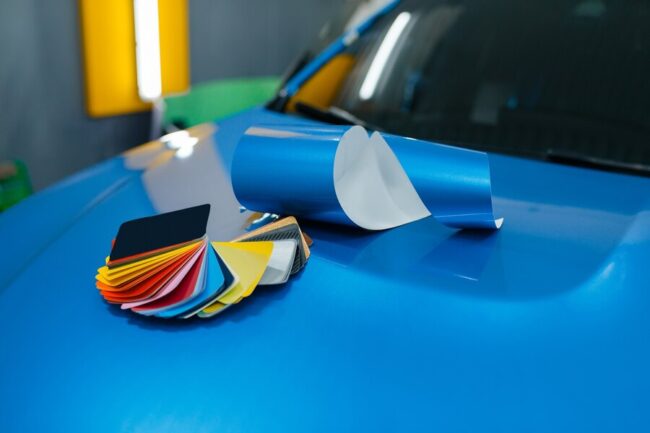When tinting your windows, the goal is often to balance privacy, comfort, and aesthetics. While reflective tint can offer some benefits, there are better choices than reflective tint, especially when you want to maintain clarity and visibility without the reflective shine. This is where non-reflective tint shines—pun intended.
Non-reflective tint, also known as non-metallic or ceramic, is designed to enhance visibility and reduce glare without the mirror-like effect of reflective tints. Whether driving in bright sunlight, dealing with headlights at night, or simply enjoying the view from your home or office, non-reflective tint provides a clear, unobstructed perspective while offering the benefits of UV protection and heat rejection.
In this blog, we’ll dive into the world of non-reflective tint, exploring its features, advantages, applications, and tips for choosing and maintaining the right tint for your needs. Join us as we uncover how non-reflective tints can enhance your visibility without the shine.
Understanding Non-Reflective Tint
Understanding non-reflective tint is essential for appreciating its unique qualities and benefits. Unlike reflective tints that bounce light off their surface, non-reflective tint absorbs and disperses light without creating a glare. This allows for improved visibility in various lighting conditions, making it particularly useful for driving during the day or night.
Non-reflective tint also offers UV protection and reduces interior heat buildup, enhancing comfort and protecting occupants and interior surfaces from sun damage. Its subtle appearance maintains the vehicle’s or building’s original look while providing practical advantages, making it a popular choice for those seeking functionality and aesthetics.
Importance Of Maintaining Visibility While Reducing Glare
Maintaining visibility while reducing glare is crucial for safety and comfort in various settings. Clear visibility is essential for safe driving in vehicles, especially in challenging conditions such as bright sunlight, oncoming headlights at night, or glare from wet roads. By reducing glare, non-reflective tint helps drivers maintain better visibility, enhancing their ability to see obstacles, pedestrians, and other vehicles on the road.
This improves safety and reduces eye strain and fatigue, leading to a more comfortable driving experience. In residential and commercial spaces, reducing glare improves comfort for occupants by minimizing harsh light that can cause discomfort and glare on screens or reflective surfaces.
It also helps maintain a more pleasant and productive environment by creating a softer, more diffused light. Maintaining visibility while reducing glare is essential for safety, comfort, and productivity in various environments.
Advantages Of Non-Reflective Tint
- Enhanced Visibility: Non-reflective tint reduces glare from sunlight, headlights, and other sources, improving visibility for drivers and occupants. This can lead to safer driving conditions, especially in bright or low-light situations.
- Glare Reduction: By absorbing and dispersing light instead of reflecting it, non-reflective tint reduces glare inside vehicles or buildings, creating a more comfortable environment for occupants.
- UV Protection: Non-reflective tint blocks a significant amount of harmful UV rays from entering the interior, which helps protect skin from sun damage and prevents fading or deterioration of interior surfaces.
- Heat Reduction: It also helps reduce interior heat buildup by blocking infrared rays, keeping the inside of vehicles or buildings more relaxed and comfortable, especially in hot climates.
- Privacy: While not as reflective as other types of tint, non-reflective tint still provides a degree of privacy by reducing the visibility of the interior from the outside. This can be beneficial for both residential and commercial applications.
- Aesthetics: Non-reflective tint maintains the original appearance of vehicles or buildings, offering a subtle enhancement without altering their overall look. This makes it a popular choice for those who want the benefits of tinting without a noticeable change in appearance.
Applications And Use Cases
- Automotive: Vehicles commonly use non-reflective tint to improve visibility without compromising aesthetics. It reduces glare from headlights, sunlight, and other bright sources, enhancing driving comfort and safety. Additionally, it helps protect the vehicle’s interior from fading and damage caused by UV rays.
- Residential: In homes, non-reflective tints can be applied to windows to balance privacy and natural light. It allows occupants to enjoy natural sunlight without harsh glare, creating a more comfortable and inviting living environment. Non-reflective tint also helps regulate indoor temperatures by reducing heat gain from sunlight.
- Commercial: In commercial settings, such as offices and storefronts, non-reflective tint is used to improve the working environment. Reducing glare on computer screens and other electronic devices enhances productivity and comfort for employees. Non-reflective tint can also help maintain a professional appearance for storefronts while providing privacy for interior spaces.
Installation And Maintenance
Professional installation is crucial for ensuring the effectiveness and longevity of non-reflective tint. Trained technicians have the expertise to properly apply the tint film properly, ensuring a seamless finish without bubbles or creases that could affect visibility. They also understand the legal regulations regarding tint darkness levels, ensuring compliance with local laws.
Maintenance of non-reflective tint is relatively simple but essential for preserving its performance. Regular cleaning with a mild soap and water solution and a soft cloth helps to remove dirt, dust, and grime that can accumulate on the surface. Avoid using abrasive cleaners or rough materials that could scratch the tint.
Periodic inspections for any signs of peeling or damage are also recommended, as prompt repairs can prevent further issues and maintain the tint’s effectiveness. Proper installation and regular maintenance can ensure that non-reflective tint continues to enhance visibility and provide UV protection for years.
 Importance Of Professional Installation For Optimal Performance
Importance Of Professional Installation For Optimal Performance
The importance of professional installation for non-reflective tint cannot be overstated, as it directly impacts the tint’s performance and longevity. Professional installers have the expertise and experience to apply the tint, ensuring a seamless, bubble-free finish. They also have access to high-quality materials and tools crucial for achieving optimal results.
Additionally, professional installers are familiar with local regulations regarding tint darkness and installation methods, ensuring compliance with legal requirements. Attempting DIY installation or using inexperienced installers can lead to subpar results, such as uneven application, air bubbles, or premature peeling, which can compromise the tint’s effectiveness and aesthetics. By investing in professional installation, you can ensure that your non-reflective tint looks excellent and performs optimally for years.
Tips For Maintaining Non-Reflective Tint For Longevity And Effectiveness
- Regular Cleaning: Clean the tinted windows with a mild soap or specialized tint-safe cleaner and a soft, non-abrasive cloth. Avoid harsh chemicals or abrasive materials that could scratch or damage the tint.
- Gentle Wiping: Use gentle wiping motions to avoid scratching the tint. Start from the top and work your way down using light pressure.
- Avoid Abrasive Materials: Do not use abrasive materials like scrubbing pads, rough sponges, or brushes on the tinted surface, as they can scratch the film.
- Avoid Ammonia-Based Cleaners: Avoid using cleaners that contain ammonia, as it can break down the adhesive used in the tint film and cause it to bubble or peel.
- Protect from Sharp Objects: Be careful when placing objects near the tinted windows to prevent scratching. Consider using window shades or covers when parking in direct sunlight for extended periods.
- Regular Inspection: Periodically inspect the tint for any signs of damage, such as bubbling, peeling, or discolouration. Address any issues promptly to prevent further damage.
- Professional Maintenance: Consider having your tint inspected and maintained annually to ensure it remains in good condition and address any potential issues early on.
Choosing The Right Non-Reflective Tint
Choosing the right non-reflective tint involves considering several factors to ensure it meets your specific needs and preferences:
- You’ll want to check the tint’s darkness level, typically measured as a percentage. Different states and countries have regulations regarding how dark tint can be, so it’s essential to comply with local laws.
- Consider the quality of the tint material and its ability to provide UV protection and heat reduction. Look for reputable brands known for their durability and performance. Some tints may offer additional features like scratch resistance or enhanced clarity.
- Think about your desired aesthetic and how the tint will complement the overall look of your vehicle, home, or office.
Choosing a tint that balances functionality with visual appeal will ensure you maximise your investment.
How To Match Tint To Specific Needs And Preferences
- Legal Regulations: Check local laws regarding tint darkness and reflective properties. Ensure that the chosen tint complies with these regulations to avoid legal issues.
- Privacy vs. Visibility: Determine the level of privacy you want versus the need for visibility. Darker tints provide more privacy but may reduce visibility, especially at night. Consider your comfort level and the intended use of the tinted area.
- UV Protection: If UV protection is a priority, choose a tint with high UV rejection rates. This is crucial for protecting your skin and interior surfaces from sun damage.
- Heat Rejection: Prioritize tints with high heat rejection properties for areas with high temperatures. This helps keep the interior cool and comfortable, reducing the need for excessive air conditioning.
- Aesthetic Preferences: Consider the overall look you want to achieve. Some tints have a matte finish, while others may have a slight sheen. Choose a tint that complements the aesthetics of your vehicle or building.
- Quality and Durability: Invest in high-quality tints known for their durability and longevity. Cheaper options may fade or bubble over time, compromising their effectiveness and appearance.
Conclusion
Non-reflective tint offers a remarkable solution for enhancing visibility without the glare or shine associated with reflective films. Its ability to reduce glare from headlights and sunlight while maintaining clarity is particularly beneficial for drivers seeking improved visibility and comfort.
Additionally, non-reflective tint provides privacy without compromising the aesthetic appeal of your vehicle’s windows. Opting for a non-reflective tint allows you to enjoy a safer and more comfortable driving experience while maintaining a sleek and understated appearance.




